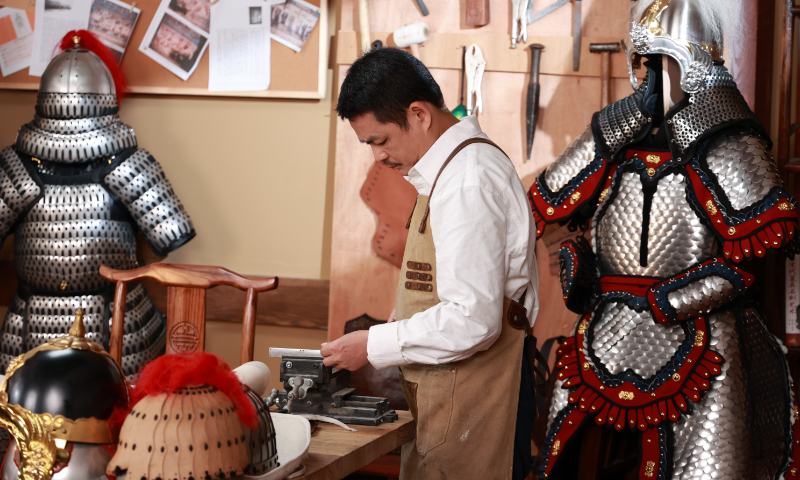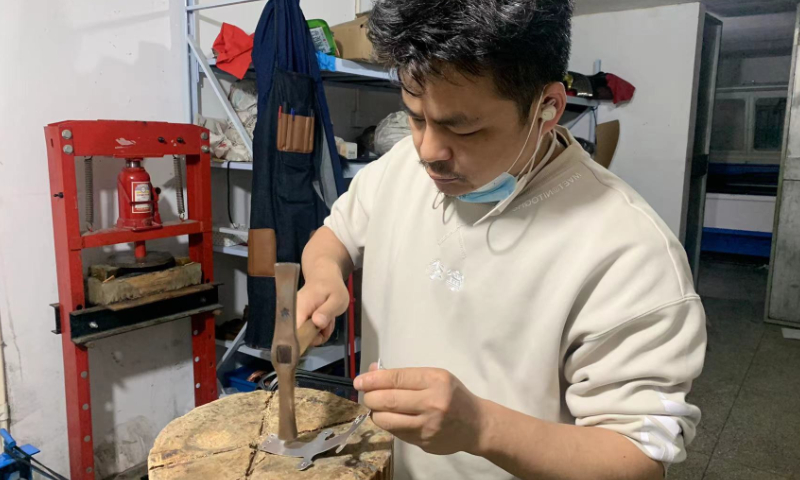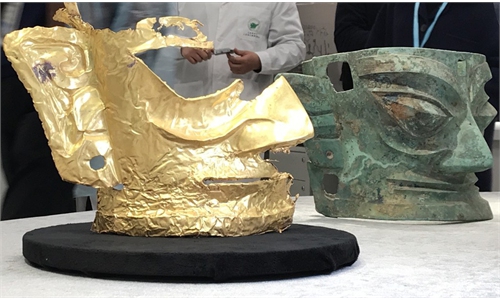ARTS / ART
Iron Man
Taking armor as spiritual protection, Chinese artisan restores and produces thousands of ancient armors in a lifetime career

Wen Chenhua is making armors. Photo: Courtesy of Wen
Visitors to the Yangguan Museum in Dunhuang, Northwest China's Gansu Province during the May Day holidays had opportunity to see the first restored Chinese "Mingguang" armor of the Tang Dynasty (618-907). The piece that can suit an adult man with a height of 1.86 meters, allowed spectators to appreciate the wisdom of Chinese ancient artisans and charm of the Chinese armor culture.
Wen Chenhua, the artisan restoring the armor that played a significant role in battlefields over 1,000 years ago, is one of the biggest fans of ancient armors in China and has taken the restoration and production of armors as his lifelong career.
When talking with the Global Times, Wen said that the protection suits for soldiers in old times have not lost their practical function today as he sees these armors as spiritual protection that can make him keep a peaceful state of mind.
Wen and his team of more than 30 members have produced over 10,000 armors according to samples of ancient pieces since 2008 and gradually gathered thousands of followers, in the country and abroad, who have been caught by the charm of the Chinese armor culture .
"We have a similar identity on the part of Chinese culture and we believe that these splendidly designed armors are symbols of our nation's glorious past," Wen said.
Difficult process
"Which one is the most difficult to be restored for me? I have to say none is easy to be restored," Wen told the Global Times.
Since 2008, when he restored an armor of the Song Dynasty (960-1279), Wen has crafted armors from the Qin Dynasty (221BC-206BC) to the Ming Dynasty (1368-1644). As some armors lacked historical records, Wen had to think of other methods to figure out what they looked like, especially some details.
In order to make a set of real armors, Wen traveled for days to museums and temples all over the country to find murals and statues of different dynasties, taking pen and paper to copy them .
Armors from the Tang and Song dynasties are Wen's favorites. He took the Mingguang armor as an example.
Mingguang is the armor's name, which refers to the pieces of the breastplate that are bright and shiny, according to Wen.
Due to the prohibition of private storage of armors in ancient dynasties, there are very few complete armors preserved in China now and there are not many detailed written records left.
Wen studied many historical records and found some words about the armor, like in battles of Li Shimin, an emperor of Tang Dynasty and ancient Korea, but most of the descriptions did not mention the appearance of the armor.
He went many times to the Dunhuang Mogao Grottoes to observe a fresco about a general of the Tang Dynasty, who lived in the area at that time, and was wearing the armor while leading his army.
He also took as reference the statues of goddesses in the Dunhuang Mogao Grottoes as armors on some of the statues still maintain their colors.
The restored Mingguang armor took Wen and his team several months. It is composed of more than 1,300 iron pieces and weighs nearly 25 kilograms. They used modern technology to create patterns that were inspired by a traditional forging technology popular in the region during the Tang Dynasty.
Wen said that all of these endeavors aim to get close to the historical truth, highlighting that "no one can see the real Mingguang armor but I will try my best to restore the truth."
Increasing visibility
Wen's obsession with armor production did not get support from his family in the beginning because they considered that his hobby was the same as playing online games and wasting money.

Wen Chenhua is making armors. Photo: Courtesy of Wen
"A mold of the armor was around 8,000 yuan ($1,200) at that time. They did not understand why I chose to make armors. But I insisted because of the longing on seeing a piece of ancient armor appearing in front of my eyes by my hands," Wen said.
Wen's persistence brought him increasing reputation among fans of Chinese traditional armor and military culture. Wen's Sina Weibo account has more than 2 million followers and the income of his workshop has reached over 6 million yuan ($900,000) each year.
His team tried producing mass production of armors with machines and turned the ancient body protection into a kind of merchandise, while continuing to restore the armors lost in history.
Local and overseas fans, including from Europe and the US, contacted Wen to purchase the armors he made. Many of overseas customers were Chinese, Wen said, adding that "our consumers uploaded photos online wearing the armors, which can attract more netizens around the world to have interest in them."
The trend of revival of traditional culture among Chinese young people also helps to take Wen's armor career to new heights. He sees it as a good opportunity.
Wen noted that he developed deep bonds with some loyal fans because of similar fondness to armors.
A young man refused a discount Wen offered and insisted on buying an expensive bronze face mask at its original price as he thought Wen's studio is having a tough time with the COVID-19 epidemic. Wen mentioned that he feels a warm connection with these people.


